This page describes the various research areas we are
working on.
For information on specific research projects go to the Projects page.
For information on specific research projects go to the Projects page.
Computational Epidemiology
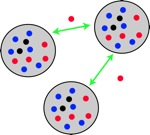
A main focus of our research is the understanding of the
dynamics of human infectious diseases. We develop
computational models, new analytic and numerical
techniques and large-scale quantitative and predictive
computer simulations to study various aspects of the
dynamics of epidemics. In this research we combine
mathematical methods from nonlinear dynamics, stochastic
processes, statistical physics, complex network theory,
and systems biology. We are interested in numerous
aspects of disease dynamics, ranging from phenomena
related to single populations to the large-scale spatial
spread of epidemics.
Our research on computational epidemiology is funded in part by
Our research on computational epidemiology is funded in part by
- the Volkswagen Foundation within the program Complex Networks as a Phenomenon across Disciplines, and
- a Large-Scale Integrating Project (IP) within the Seventh Research Framework Programme (FP7) of the European Union: EPIWORK – Developing the framework for an epidemic forecast infrastructure.
Spatial Dynamics of Infectious Diseases

We investigate to what extent human transportation
networks and human mobility shape spatio-temporal disease
dynamics. One of our goals is to determine and extract
those statistical features of mobility networks that are
most significant in determining typical (possibly
universal) features of disease dynamics. This research is
closely related to our projects on the structure of
large- and multi-scale human mobility networks and to our
research on fractional diffusion in heterogeneous
environments.
See also The Origin of Wheresgeorge Research
Disease Dynamics in Heterogeneous Populations
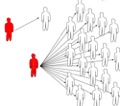
In addition and in combination with models for the
spatial spread of diseases we investigate the impact of
social and behavioral heterogeneities on the time course
of an epidemic in single populations. These differences
could be seen in age-dependent transmission and recovery
rates, pronounced variability in individual behavior, or,
most importantly, in a broad distribution of contact
rates. We are particularity interested in disease models
that exhibit qualitatively new dynamics as a consequence
of strong behavioral heterogeneities. To answer these
questions we develop agent-based simulations in which
each interacting unit is equipped with a set of
individual parameters that are drawn from distributions
that reflect the population’s heterogeneity.
Stochasticity in Disease Dynamics
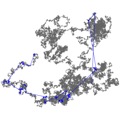
Disease dynamics, the interplay of transmission and
recovery in a population, are inherently stochastic
processes, as individual events and interactions cannot
be predicted. These stochastic effects are often ignored
in mean-field models for disease dynamics. However,
stochastic effects due to fluctuations dominate the time
course of an epidemic, and in fact these effects are
strongest at the epidemic’s onset. In a number of
projects we aim to develop a systematic approach for
incorporating stochastic effects into epidemic models. Of
particular interest to us are emergent phenomena that
arise in systems in which nonlinear dynamics, randomness,
and spatial heterogeneity are combined, a condition
typically met in epidemic contexts.
Human-mediated Bioinvasion
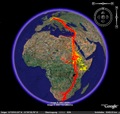
The phenomenon of human-mediated bioinvasion is
conceptually related to the spatial spread of epidemics.
Bioinvasion refers to the geographical expansion of a
species into a new area in which they proliferate and
persist to the detriment of the environment. Brought
about largely through human transport and commerce, it is
now recognized as one of the leading causes of the global
biodiversity crisis. There is a great deal of evidence
for the negative impact of alien invasive species on
local species and habitats. Bioinvasion can lead to
species extinction, loss of biodiversity, alteration of
ecosystem function, and economic damage. A single
introduced species can cause dramatic structural and
functional changes: the introduction of the Nile perch to Lake Victoria brought
about the extinction of over one hundred endemic
fish species, the largest modern vertebrate
extinction known. In collaboration with Bernd Blasius (ICBM, Oldenburg,
Germany) and funded by the Volkswagen Foundation within the
framework Complex Networks as a Phenomenon
across Disciplines, we develop models for
human-mediated bioinvasion processes on human
transportation networks in order to quantify the
susceptibility of various regions to bioinvasion
threats and in order to develop more efficient
containment strategies.
Projects:
Publications:
- L. Hufnagel, D. Brockmann and T. Geisel:
Forecast and control of epidemics in a
globalized world. Proc Natl Acad Sci
USA 101, 15124 (2004).
 pdf
pdf - D. Brockmann, L. Hufnagel and T. Geisel:
The scaling laws of human travel.
Nature 439, 462 (2006).
 pdf
pdf - D. Brockmann: Human Mobility and Spatial
Disease Dynamics. In Reviews of Nonlinear
Dynamics and Complexity, H. G. Schuster (ed.),
Wiley-VCH (2009).
 pdf
pdf
Complex Networks and Human Mobility
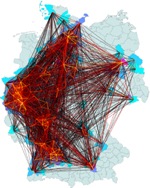
A key focus of our work is to reach a deeper
understanding of complex biological and artificial
networks. Particularly in connection to our research on
spatial disease dynamics we are interested in the
structure and properties of human mobility networks. Many
of these networks can be described by a symmetric weight
matrix whose elements are positive numbers that measure
the flux of individuals between nodes. Transportation
networks are usually strongly heterogeneous: the weights
(traffic between nodes), capacities (total traffic
through a node), and degrees (number of connections of a
node) all exhibit very broad distributions. Unlike other
complex networks such as author citation or gene
regulatory networks, transportation networks are embedded
in a metric space. This raises a number of interesting
questions such as: How much of the embedding space is
encoded in a transportation network? How do the
statistical properties of a network depend on length
scale? What are the differences between various
transportation networks, and, more interestingly, what
features do they share? Do nodes play different roles in
a network based on their connectivity? How can these
roles be characterized? What can transportation networks
tell us about the connectivity of spatially distributed
communities? Examples of networks we investigate are the
worldwide air transportation network and multi-scale US
and European networks, incorporating all means of
transportation.
See also The Origin of Wheresgeorge Research
Projects:
- Community Structure in Multi-Scale Transportation Networks
- Beyond percolation theory: A local perspective of network resilience to real-world disasters
- Travel Bugs, Geocaching and European Traffic Networks
- The Scaling Laws of Human Travel
- Tour de Sys: The Traveler's View of a Network
- Universality in Multi-scale Transportation Networks
Publications:
- D. Brockmann and F. Theis: Money
Circulation, Trackable Items, and the Emergence of
Universal Human Mobility Patterns.
Pervasive Computing 7, Nr. 4,
28 (2008).
 pdf
pdf - L. Hufnagel, D. Brockmann and T. Geisel:
Forecast and control of epidemics in a
globalized world. Proc Natl Acad Sci
USA 101, 15124 (2004).
 pdf
pdf - D. Brockmann, L. Hufnagel and T. Geisel:
The scaling laws of human travel.
Nature 439, 462 (2006).
 pdf
pdf - D. Brockmann: Anomalous diffusion and the
structure of human transportation networks.
European Physical Journal - Special Topics
157, 173-189 (2008).
 pdf
pdf
Complex Dynamics in Biological Systems
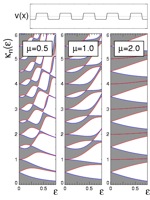
Complex dynamical phenomena in biological systems across
many orders of magnitude in length scale are governed by
the interplay of nonlinear interactions, structural
inhomogeneities, randomness, and topological complexity
of the internal interactions. Examples of such systems
abound: gene regulatory systems, metabolic networks,
intracellular transport, and entire ecosystems all share
a surprising number of features. Despite their complexity
and regardless of length scale, they are surprisingly
robust with respect to external perturbations and
flexible with respect to internal changes. Using methods
from systems biology, nonlinear dynamics, and stochastic
processes we investigate the dynamics of these biological
systems in a number of case studies. In one focus area we
model the facilitated target localization of
transcription factors on DNA based on intersegment
transfer due to the dynamic thermal folding of DNA. Along
a more theoretical line of research we investigate
particle reaction kinetics in regulatory networks, with a
particular emphasis on the impact of stochasticity in
combination with the complex coupling of the network.
Anomalous Diffusion and Fractional Transport
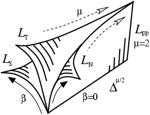
Anomalous diffusion processes are random dispersal
processes that exhibit a temporal scaling of position
that is in conflict with the square root behavior of
ordinary diffusion (Brownian motion). Processes that
disperse faster are called superdiffusive, and those that
disperse more slowly, subdiffusive. Our research on
anomalous diffusion processes focuses mostly on anomalous
diffusion processes when they evolve in structured
environments or when they are subjected to spatially
variable forces or potentials. We developed a theoretical
framework employing fractional Fokker–Planck equations in
which the anomalous diffusion in the face of spatial
heterogeneities can be described consistently. A key
prediction made by these models is that the combination
of anomalous diffusion in a structured environment can
exhibit surprising and counterintuitive behavior.
Publications:
- D. Brockmann and L. Hufnagel: Front
propagation in reaction-superdiffusion dynamics: Taming
Levy flights with fluctuations. Phys Rev
Lett 98, 178301 (2007).
 pdf
pdf - D. Brockmann and T. Geisel: Particle
dispersion on rapidly folding random
heteropolymers. Phys Rev Lett
91, 48303 (2003).
 pdf
pdf - D. Brockmann and T. Geisel: Levy flights in
inhomogeneous media. Phys Rev Lett
90, 170601 (2003).
 pdf
pdf - D. Brockmann and I. M. Sokolov: Levy
flights in external force fields: from models to
equations. Chem Phys
284, 409 (2002).
 pdf
pdf